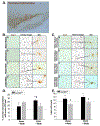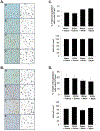Neurotoxicity to dopamine neurons after the serial exposure to alcohol and methamphetamine: Protection by COX-2 antagonism
- PMID: 31228610
- PMCID: PMC6754766
- DOI: 10.1016/j.bbi.2019.06.028
Neurotoxicity to dopamine neurons after the serial exposure to alcohol and methamphetamine: Protection by COX-2 antagonism
Abstract
A significant co-morbidity exists between alcohol and methamphetamine (Meth) in humans but the consequences and mechanisms underlying their co-morbid effects remain to be identified. A consequence associated with the abuse of either alcohol or Meth involves inflammation but little is known about the role of inflammation in a possible neurotoxicity arising from their co-exposure. Sprague Dawley rats were allowed 28 days of intermittent, voluntary access to 10% ethanol (EtOH) followed by a neurotoxic binge administration of Meth. EtOH drinking followed by Meth increased microglial cell counts and produced morphological changes in microglia of the substantia nigra pars compacta 2 h after Meth administration that were distinct from those produced by either EtOH or Meth alone. These effects preceded the activation of cleaved caspase-3 in dopamine cell bodies, as well as decreases in tyrosine hydroxylase (TH) immunoreactivity in the substantia nigra and dopamine transporter (DAT) immunoreactivity in the striatum measured at 7 days after Meth. Intervention with a selective COX-2 inhibitor during EtOH drinking prevented the changes in microglia, and attenuated the increase in cleaved caspase-3, and decreases in TH and DAT after Meth administration. Furthermore, motor dysfunction measured by a rotarod test was evident but only in rats that were exposed to both EtOH and Meth. The motor dysfunction was ameliorated by prior inhibition of COX-2 during EtOH drinking. The exaggerated neurochemical and behavioral deficits indicate that the comorbidity of EtOH and Meth induces a degeneration of the nigrostriatal pathway and support the role of inflammation produced by EtOH drinking that primes and mediates the neurotoxic consequences associated with the common co-morbidity of these drugs.
Copyright © 2019 Elsevier Inc. All rights reserved.
Figures









Similar articles
-
Serial exposure to ethanol drinking and methamphetamine enhances glutamate excitotoxicity.J Neurochem. 2019 Dec;151(6):749-763. doi: 10.1111/jnc.14861. Epub 2019 Oct 15. J Neurochem. 2019. PMID: 31478210 Free PMC article.
-
Overexpression of parkin in the rat nigrostriatal dopamine system protects against methamphetamine neurotoxicity.Exp Neurol. 2013 Sep;247:359-72. doi: 10.1016/j.expneurol.2013.01.001. Epub 2013 Jan 9. Exp Neurol. 2013. PMID: 23313192 Free PMC article.
-
Epothilone D prevents binge methamphetamine-mediated loss of striatal dopaminergic markers.J Neurochem. 2016 Feb;136(3):510-25. doi: 10.1111/jnc.13391. Epub 2015 Dec 10. J Neurochem. 2016. PMID: 26465779 Free PMC article.
-
Detection of methamphetamine neurotoxicity in forensic autopsy cases.Leg Med (Tokyo). 2009 Apr;11 Suppl 1:S63-5. doi: 10.1016/j.legalmed.2009.01.003. Epub 2009 Mar 6. Leg Med (Tokyo). 2009. PMID: 19269222 Review.
-
Is there a role for nitric oxide in methamphetamine-induced dopamine terminal degeneration?Neurotox Res. 2014 Feb;25(2):153-60. doi: 10.1007/s12640-013-9415-2. Epub 2013 Aug 6. Neurotox Res. 2014. PMID: 23918001 Free PMC article. Review.
Cited by
-
Icariside II Attenuates Methamphetamine-Induced Neurotoxicity and Behavioral Impairments via Activating the Keap1-Nrf2 Pathway.Oxid Med Cell Longev. 2022 Mar 28;2022:8400876. doi: 10.1155/2022/8400876. eCollection 2022. Oxid Med Cell Longev. 2022. PMID: 35387263 Free PMC article.
-
Toxic Effects of Methamphetamine on Perivascular Health: Co-morbid Effects of Stress and Alcohol Use Disorders.Curr Neuropharmacol. 2021;19(12):2092-2107. doi: 10.2174/1570159X19666210803150023. Curr Neuropharmacol. 2021. PMID: 34344290 Free PMC article. Review.
-
Combined and sequential effects of alcohol and methamphetamine in animal models.Neurosci Biobehav Rev. 2021 Dec;131:248-269. doi: 10.1016/j.neubiorev.2021.09.019. Epub 2021 Sep 17. Neurosci Biobehav Rev. 2021. PMID: 34543650 Free PMC article. Review.
-
Role of Microglia in Psychostimulant Addiction.Curr Neuropharmacol. 2023;21(2):235-259. doi: 10.2174/1570159X21666221208142151. Curr Neuropharmacol. 2023. PMID: 36503452 Free PMC article. Review.
-
A prior history of binge-drinking increases sensitivity to the motivational valence of methamphetamine in female C57BL/6J mice.Subst Abuse. 2020 Jan 20;14:1178221819897073. doi: 10.1177/1178221819897073. eCollection 2020. Subst Abuse. 2020. PMID: 32009790 Free PMC article.
References
Publication types
MeSH terms
Substances
Grants and funding
LinkOut - more resources
Full Text Sources
Medical
Research Materials
Miscellaneous

